#Marie Louise d'Orléans
Photo
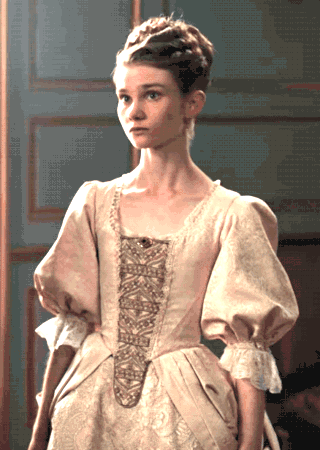
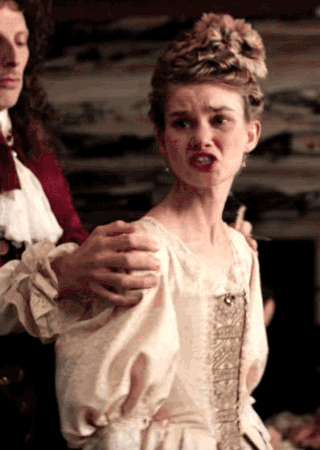

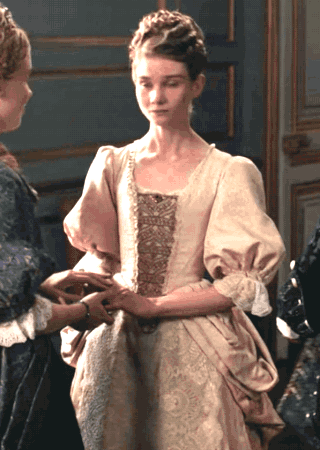


(Almost) Every Costume Per Episode + Marie Louise d'Orleans’s off white bodice and skirt with gold printed stomacher in 3x06,7
#Versailles#VersaillesEdit#VersaillesTV#perioddramaedit#weloveperioddrama#period drama#perioddrama#Marie Louise d'Orleans#Marie Louise d'Orléans#The Wheel of Fortune#The Book of Revelation#costumeedit#costumes#costume edit#costume drama#costume set#costume series#Almost Every Costume Per Episode#historical drama#Frances Pooley#Awkward-Sultana
111 notes
·
View notes
Photo

Portrait of Marie Louise d'Orléans (1662-1689). Attributed to Louis Ferdinand Elle the Elder.
#Louis Ferdinand Elle the Elder#royaume de france#maison d'orleans#bourbon orleans#marie louise d'orléans#petite fille de france#reine d'espagne#vive la reine
16 notes
·
View notes
Text
Louise Bourgeois (Louise Boursier), 1563-1636
Midwife to Queen Marie de Médicis, renowned author of medical textbooks translated into many languages

Born in Paris, Louise Bourgeois in 1584 married the king’s surgeon Martin Boursier, with whom she had five children. She led a very happy life. But during the Religious Wars, the Boursier family was forced to leave Paris and find refuge in Tours, where they suffered a life of financial difficulties. Returning to Paris, Louise Boursier became a midwife to provide financial assistance to her family. In spite of opposition from within the profession, she practiced for five years among the poor and became a registered midwife in 1598. This period of her life is recounted at the beginning of her Recit veritable de la naissance de messeigneurs etdames les enfans de France (True Account of the Birth of the Sons and Daughters of France).
In 1601, a wonderful opportunity was offered to Louise Boursier: Queen Marie de Médicis was looking for a midwife. Demonstrating a strong sense of authority and loyalty, Louise Boursier was chosen by the queen to deliver her six children between 1601 and 1610 (the year King Henry IV was assassinated). Louise Boursier was well respected and became the most popular midwife at the court.In 1627, however, Marie de Bourbon Montpensier gave birth to her daughter, Anne-Marie-Louise d’Orléans (La Grande Mademoiselle),and died suddenly of a puerperal fever. Her midwife, Louise Boursier, was accused of negligence by the physicians who did the autopsy. Her popularity began to decline, and she spent the rest of her life writing and publishing very successful books about her art until her death in 1636. Her famous works were read all over Europe. First published in 1609, her Observations diverses, sur la stérilité, perte de fruict, foecondité, accouchements, et maladies des femmes, et enfants nouveaux naiz (Various Observations on Sterility, Miscarriage, Ability to Conceive, Childbirth, Female Illnesses,and Infants) provides scientific remarks on obstetrics and numerous guidelines for the care of the pregnant woman as well as her infant. Becoming the manual of reference, this book was augmented and published again and again (in 1617, 1626, 1634, 1642, and 1652). It was also translated into Latin, German, Dutch, and English, underscoring the importance of her European reputation at that time. Some parts of her works are of particular interest: Recueil des Secrets, de Louyse Bourgeois dite Boursier (Book of Secrets of Louise Bourgeois Boursier), published just before she died (1635), is a compilation of recipes for women for the treatment of ailments such as skin eruptions, painful periods, and the like.The most interesting writings of Louise Boursier are the Récit véritable (True Account) and the Instruction à ma fille (Advice to my Daughter), both published in 1617, where she presents her short autobiography as well as the spiritual testament of an exemplary midwife.
In her own time, the well-educated and highly competent Louise Boursier was something of an anomaly, first among her male coworkers, who came to resent her as she became a self-confident practitioner, and also among other sworn midwives who saw her as a formidable challenger to their own preeminence in the field because of her marriage to a surgeon and her unusual training (Louise had studied Ambroise Paré’s book on obstetrics). Furthermore, important changes were taking place in the medical and surgical professions. For centuries, women, having gained their skills from experience, monopolized midwifery. With the upsurge of medical science in the sixteenth century, physicians became more interested in the art of delivery, and, as organized instruction and licensing became prevalent, these requirements extended also to women engaged in midwifery.
In a time of growing suspicion over women’s capacities to handle child delivery, Louise Boursier understood the need for formal training and collaboration with male physicians and surgeons. She saw herself as the founder of a new generation of midwives, more knowledgeable and better trained. In her effort to educate those who would follow her, she published Instruction à ma fille, the first treatise in French on the art of midwifery. She recorded her theories on maternity care and her experiences in Parisian society in her Récit veritable. This important work provides a unique source of information about midwifery practices in the early modern period as well as insights into the challenges women faced as they entered the professional world.
Colette H. Winn, in Encyclopedia of Women in the Renaissance
#xvi#xvii#louise bourgeois#louise boursier#midwifery#marie de médicis#ambroise paré#marie de bourbon-montpensier#anne-marie-louise d'orléans#la grande mademoiselle#encyclopedia of women in the renaissance#colette h. winn
10 notes
·
View notes
Photo
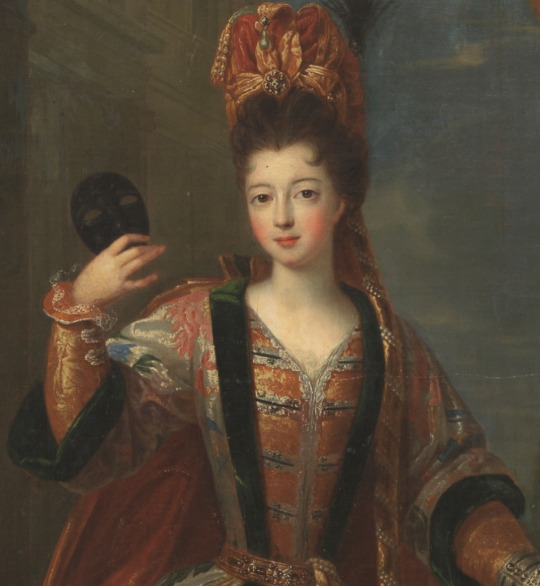
Pierre Gobert (French, 1662-1744)
Marie Louise Élisabeth d'Orléans, Duchess of Berry, Detail, 1714
#Pierre Gobert#french#france#Marie Louise Élisabeth d'Orléans#duchess#art#european history#world history#art history#european#brunette#female portrait#dark eyes#Aristocracy#caucasian#aristocrat
20 notes
·
View notes
Photo



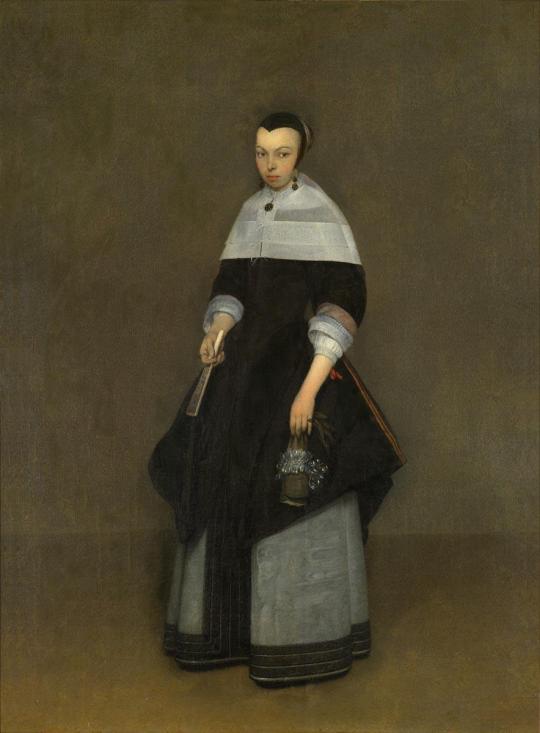

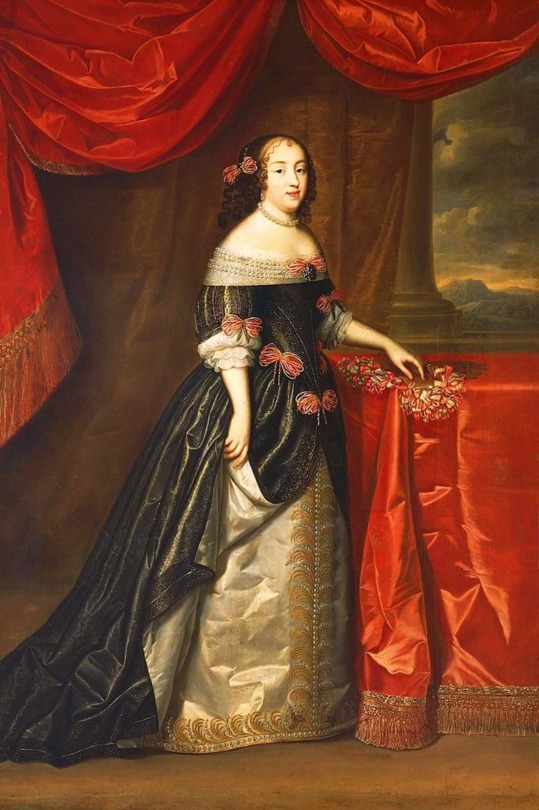

Baroque era dress (from top to bottom) -
Maria Leopoldine of Austria, Holy Roman Empress, 1632-1649 by Justus Sustermans (location ?). From tumblr.com/blog/view/catherinedefrance; erased spots & cracks w Pshop 2048X2579 @72 1.8Mj.
1655 Anna María Luisa de Orléans by Charles Beaubrun and Henri Beaubrun (Prado). From tumblr.com/blog/view/roehenstart; removed obvious spots & flaws in background w Pshop 1502X1858 @72 976kj.
Young aristocrat by Joachim von Sandrart (Hampel - 30Jun22 auction Lot 338). From invaluable.com-auction-lot-joachim-von-sandrart-1606-frankfurt-am-main-1688--338-c-35f4b3f83e 1330X1696 @72 3.2Mp 1330X1696 @72 3.2Mp.
1661 Lady by Gerard ter Borch (State Pushkin Museum of Fine Arts - Moskva, Russia). From tumblr.com/blog/view/shewhoworshipscarlin 884X1200 @72 205kj.
Marie Therese, Queen of France (1638-1683) attributed to Jean Nocret (Hermitage Fine Art - 8Jul20 auction Lot 573). From invaluable.com/auction-lot/jean-nocret-1615-1672-attributed-to-marie-therese-573-c-aa342d1aff 1000X1361 @72 231kj.
Marguerite Louise d'Orléans, Grand Duchess of Tuscany (1645-1721) by Henri and Charles Beaubrun (location ?). From tumblr.com/blog/view/roehenstart 1064X1600 @72 358kj.
ca. 1672-1675 Maria Isabella Capranica Cerri by Jacob Ferdinand Voet (Palazzo Chigi - Roma, Italy). From tumblr.com/blog/view/history-of-fashion; erased spots w Pshop 480X612 @72 107kj.
#Baroque fashion#Louis XIV fashion#1650s fashion#1660s fashion#1770s fashion#Maria Leopoldine of Austria#Justus Sustermans#Anna María Luisa de Orléans#Beaubrun#Beaubrun brothers#Joachim von Sandrart#Gerard ter Borch#Queen Marie Therese#Jean Nocret#Marguerite Louise d'Orléans#Maria Isabella Capranica Cerri#Jacob Ferdinand Voet#straight hair side curl coiffure#collar#bertha#lace bertha#hair ribbons#V waistline#full skirt.
12 notes
·
View notes
Text
Today's random fanfiction is from the L'Échange des princesses | The Royal Exchange (2017) fandom. Rien à voir. by AngelicaR2
Chapters: 1/1
Words: 336
Fandom: 18th Century CE RPF, L’Échange des princesses | The Royal Exchange (2017)
Rating: General Audiences
Warnings: No Archive Warnings Apply
Relationships: Mme de Ventadour & Marie Anne Victoire d'Espagne
Characters: Mme de Ventadour, Marie Anne Victoire d'Espagne, Louis XV de France, Louise-Élisabeth d'Orléans
Additional Tags: Spain, Versailles - Freeform, 18th Century, Drabble, Hope, Travel, differences
Language: Français
Summary: [L’Échange des princesses] : Drabble. “Marie Anne Victoire n'a rien à voir avec Louise-Elizabeth, et Mme de Ventadour espère sincèrement que cela ne va pas changer.”
#fic rec#random fanfiction#random#random recs#fanfic#ao3#fanfiction recommendation#fanfic rec#fanfiction#ao3 fanfic#18th Century CE RPF#L’Échange des princesses | The Royal Exchange (2017)#Mme de Ventadour & Marie Anne Victoire d'Espagne#Mme de Ventadour#Marie Anne Victoire d'Espagne#Louis XV de France#Louise-Élisabeth d'Orléans#Spain#Versailles - Freeform#18th Century#Drabble#Hope#Travel#differences
0 notes
Text

ab. 1647 Attr. to Louis Ferdinand Elle the Elder - Anne Marie Louise d'Orléans, Duchess of Montpensier
(Galleria Sabauda, Turin)
72 notes
·
View notes
Text


Mary of Hungary, Queen of Hungary 1516-1526, Governor of the Netherlands 1531-1555
Called mannish for "her authoritarian manner, her overly public life and her 'masculine' activities".
Carlos II, King of Spain, reigned 1665-1700
Caused a succession crisis, but not intentionally.
from anon:
"-patron of the arts! had some very good court painters - claudio coello, luca giordano, and juan carreño de miranda
-appointed capable ministers like medinaceli and oropesa
-loved his first wife marie-louise d'orléans very much
-was a silly funny little guy who liked to play harmless pranks on his courtiers
-listen we know the whole succession crisis was a clusterfuck but it was NOT carlos's fault!!! he tried his best to navigate through it and the first candidate he picked (joseph ferdinand of bavaria) was actually a good choice but he died in 1699 so carlos had to fucking go all the way back to square ONE and he knew he couldnt please everyone with his choice
-had a very funny episode of teenage rebellion when he allied with his bastard brother don juan of austria against his own mother the queen regent"
from @master-of-the-opera-house:
Intersex icon 💛💜
No heirs but spawned countless memes inaccurate or not we all have him to thank <3
Mentally eel girlies rep
Historians still get him wrong: scapegoat for everything going into shit when it really was just the snowballed problems of monarchy and generations of inbreeding he did not have agency in like literally everyone was inbred anyway
He was NOT totally incapable of ruling and NOT a puppet king
Extremely poor little meow meow-core
Emo goth girlies rep
Nice hair at least for a while
18 notes
·
View notes
Text

The funeral of Anne-Marie-Louise d'Orléans, discussed in The Devils of Loudun by Aldous Huxley, 1952
She died at the Palais du Luxembourg in Paris on 5 April 1693. As a "Granddaughter of France", she was buried at the Royal Basilica of Saint Denis outside Paris on 19 April. At her funeral, according to Saint-Simon, she was noted as being "the wealthiest single princess of Europe".
Lying in state, the urn containing her entrails exploded mid-ceremony, which caused chaos as people fled to avoid the smell. Eventually, the ceremony continued with the conclusion of it being "[...] another jest at the expense of Mademoiselle".
52 notes
·
View notes
Text
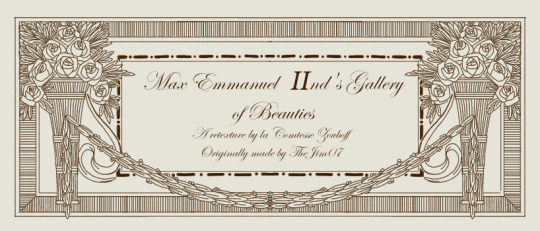




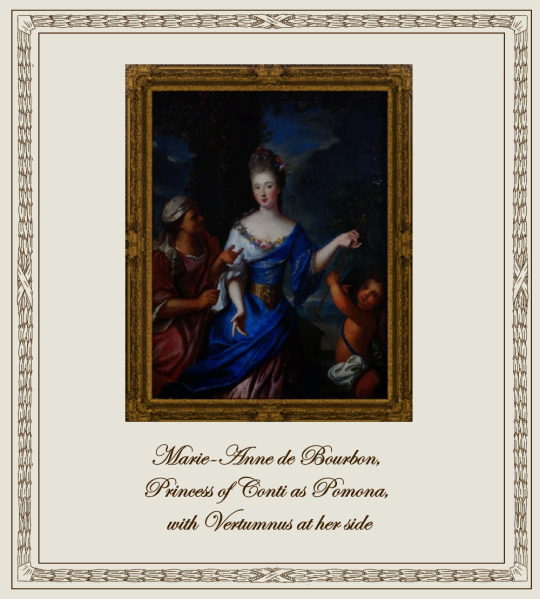

Max Emmanuel II's Gallery of Beauties
A retexture by La Comtesse Zouboff — Original Mesh by @thejim07
Elector Max Emanuel’s Great Gallery of Beauties shows five portraits of ladies at the court of Louis XIV, painted by Pierre Gobert around 1715, brought from the Palace of Versailles, these paintings displayed ladies and princesses of the french court at the dawn of Louis XIV's life.
This set contains 5 portraits, with the original frame swatches, fully recolourable. The portraits are of:
Marie-Anne de Clermont, Duchess of Joyeuse with a dog.
Marie Anne de Bourbon-Conti, Princess of Conti as Venus with Cupid
Marie Louise Élisabeth d'Orléans, Duchess of Berry
Louise Françoise de Crussol d'Úzès, Marquise of Gondrin as venus with cupid
Marie-Anne de Bourbon, Princess of Conti as Pomona, with Vertumnus at her side (replacing the portrait of Madame de Charolois, as no decent pictures of the portrait exists)
Found under decor > paintings for 2.090§
Retextured from the "Portrait of the Duchess of Angoulême" found here
-------------------------------------------------------
CC shown here:
Wall paneling and floor by @thejim07
Loveseat, armchairs and chairs by @aroundthesims
Doors by @joojconverts

Drive
(Sims3Pack | Package)
(Useful tags below)
@joojconverts @ts3history @ts3historicalccfinds @deniisu-sims @katsujiiccfinds
-------------------------------------------------------
#the sims 3#ts3#sims 3 cc#s3cc#sims 3#sims 3 download#portrait#sims 3 decor#sims 3 art#nymphenburg#louis xiv#palace of versailles#pierre gobert#wall decor
32 notes
·
View notes
Text
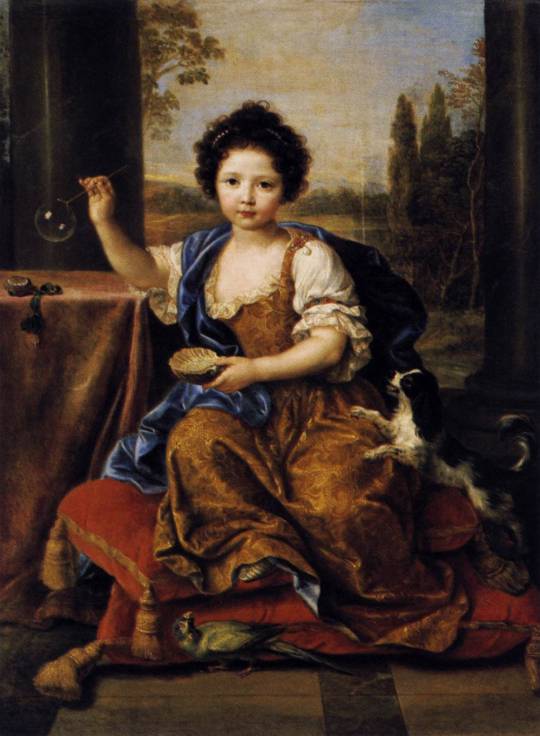
"Louise-Marie de Bourbon, dite Mademoiselle de Tours; La fillette aux bulles de savon"
By Pierre Mignard
Oil Painting, 1681.
Château de Versailles.



PORTRAIT SUBJECT
La fillette aux bulles de savon, or the commonly found English title, Girl Blowing Soap Bubbles, is a portrait of innocence during the Franco-Dutch War.
The child shown is Louise-Marie de Bourbon, the daughter of the Sun King, Louis XIV, and his Maîtresse-en-titre, Françoise-Athénaïs de Rochechouart (Madame de Montespan). I'm sorry, I don't know why they popped off with the names like that when they're planning to reuse Marie and Louis fifty times over ptdr. Louise-Marie, affectionately known as Toutou, was an illegitimate birth (1674), later legitimized by her father when she was around two years old. She held the title of Mademoiselle de Tours from then until her untimely death in 1681.
According to sources, Mignard's painting of the six-year-old girl was finished posthumously. But, her innocence is held delicately, frozen in time on canvas.

THEMES OF CHILDHOOD INNOCENCE (TL;DR: YAPANESE)
Mignard's choice to paint Louise-Marie as an actual child was uncommon for the time (even centuries later, believe it or not; maybe not so good examples, but for argument-sake: Louis XV by Hyacinthe Rigaud, Mariana Victoria of Spain by Nicolas de Largillierre, Phillip II, Duke of Orléans, Reagent of France by Largillierre, and Élisabeth Charlotte d'Orléans, "Mademoiselle de Chartres" by Largillierre -- apologies for throwing you strays, man, I'm trying to finish writing this and your children portraits were on the same website next to each other x), as young royalty are painted either as babies (unbreeched/baptize gown) or as tiny adults (fixed in uncomfortable poses and wearing clothes a monarch would), no in between. Here, Louise-Marie is playing with bubbles, her dog jumping towards it, and she looks carefree, still with chubby cheeks of rose. It doesn't help much that children were seen as heirs to the family fortune, especially during a time when parents had multiple kids due to illness (premature death) and bringing in income (need I explain more... *cough cough* coal mines... a bit anachronistic, sorry breaker boys, some other time we'll discuss y'all).
A painting such as this one, showing a realistic human experience from a royal status and that of a child BEING a child, innocence still intact, is quite important, even in today's form. We take childhood for granted, and kids are forced to grow up despite having more rights now than before. It can be a portrait to remind us that innocence is vital (a lack of childhood is detrimental as the experience is needed in order to mature mentally and emotionally when entering the teen and adult stages of life), but also that we as humans weren't so different from back then (sure, you can claim we bathe more than they do despite your husband still not washing his ass, but my heavens, did the thought 'wait, they had bubbles back then' ever occur to you?).
Genuinely, I was going to pull a La Muse Verte (the post where I briefly explained the history of absinthe) and go into the history of bubbles... because you gotta admit, that'd be fun for the both of us. However, delving into the background and theme of this painting became more heartbreaking for me. The bubble idea isn't gone, but it'll be postponed as a full history lesson post (and, yes, Mignard's painting of the immortalized Toutou will be recycled).

FURTHER READING (EXTRA SYMBOLISTIC DETAIL)
Plenty more symbolism is present, but I highly recommend you all check out L'Art en Tête's in-depth article on Mignard's beautiful portrait. I did regurgitate some of the author's points in this because I thought they were brilliant, and you can tell they have an art-history degree, so I'm begging you to go over there for more detail if interested!

#art#painting#oil painting#artwork#history#french#french art#17th century#1600s#1600s art#late 1600s#17th century art#baroque#Pierre Mignard#Château de Versailles#versailles#Royalty#French history#louis xiv#sun king#symbolism#louise-marie#mademoiselle#art history#house of bourbon#early modern period#kingdom of france
6 notes
·
View notes
Text

Portrait of Anne of Austria (1601-1666), wife of Louis XIII of France.
It’s probably a depiction of Anne Marie Louise d'Orléans (1627-1693), granddaughter of Henry IV of France. Circle of Charles Beaubrun.
#royaume de france#maison de bourbon#anne d'autriche#reine de france#vive la reine#anne marie louise d'orléans#duchesse de montpensier#la grande mademoiselle#maison d'orléans#bourbon orleans#charles beaubrun
4 notes
·
View notes
Text
"I am at present in undeserved disgrace."
As the examples of, among others, Marie de Medici, the duchesse de Longueville and the Grande Mademoiselle had demonstrated, the king's relationships with his closest female relatives was potentially as troublesome as that with any prince. After 1661, Louis XIV's principal concern was to uphold his own authority and to prevent the almost inevitable household disputes from threatening the tranquillity of his court. With so many men on active military service, Versailles during the later years of the reign was very much a feminine sphere, and disgrace was a no less constant preoccupation for aristocratic women who were determined to preserve their own personal and dynastic interests. Madame, duchesse d'Orléans, frequently returned to the theme. As a woman of trenchant and forthright views, she had struggled to remain in the king's good graces. In January 1691, she noted with pleasure that the king had paid some of her gambling debts, which she interpreted as a sign "that I am not so deeply in disgrace this year at last." Her good fortune proved short-lived, and many of her problems stemmed from her unguarded correspondence and her almost legendary hostility to the marquise de Maintenon. By September 1696, she could write venomously that:
"I am at present in undeserved disgrace. Whenever I come in the king's apartment the dirty old slut [Maintenon] withdraws and when I beg her to remain, she makes no reply but goes out with a sneer on her face. I am being treated in a very rude fashion. Every day I am forced to wait half-an-hour at the king's door before I am allowed to enter, and sometimes I am even sent away, although at the same time all the king's bastards and even Monsieur himself are in the room."
Some of her discomfiture on this and other occasions may have arisen from impatience with the dictates of protocol, but even if that was the case her sensitivity to every personal or ceremonial slight was typical of court society as a whole.
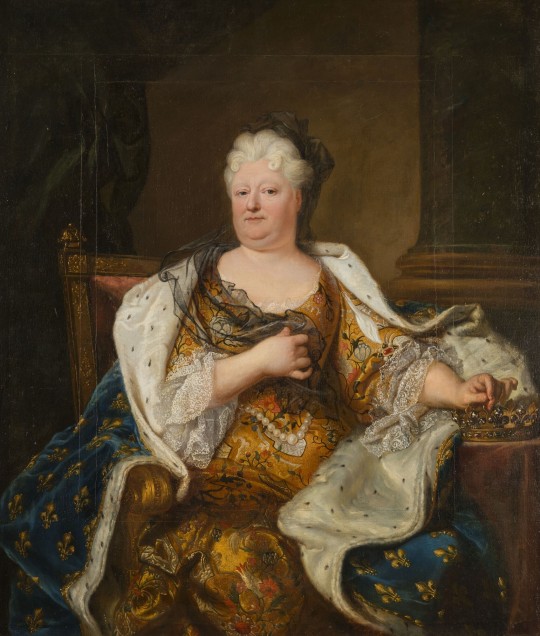
Julian Swann- Exile, inprisonment or death- The Politics of Disgrace in Bourbon France
#xvii#julian swann#exile inprisonment or death: the politics of disgrace in bourbon france#marie de médicis#anne geneviève de bourbon condé#madame de longueville#la grande mademoiselle#anne marie louise d'orléans#louis xiv#la princesse palatine#élisabeth charlotte du palatinat#madame de maintenon
18 notes
·
View notes
Text

Letter from Sophie Charlotte, Duchess of Alençon, to her daughter Louise, dated February 25 of 1895:
(Machine translation)
Heartfelt letter to her daughter Louise Victoire d'Orléans, Princess of Bavaria (1869-1952), who was staying at the spa in Bad Langenschwalbach, Hesse, and to whom Sophie Charlotte addresses herself tenderly as "My dear baby". She thanks her for sending her a book and writes family news and greetings to Louise's husband Alfons of Bavaria. Sophie Charlotte needs a hint for Louise's birthday present and regrets on the one hand that Louise will have to stay in the sanatorium for an unforeseeable time, but on the other hand she hopes for a successful cure. The state of mind of her sister and Louise's aunt, Marie in Bavaria, was sad after the recent loss of her husband Francesco II of Sicily: "Since we did not know your address, writing and telegraphing were not possible - so Papa and I would now like to know what we can give you for your birthday and name day. Whether you want toilet articles or something else, or rather finances […] The length of time there can of course not be calculated in advance and above all you must stay as long as the doctor finds it necessary […] Bubi [probably Sophie's son Philippe Emmanuel] came for a few days, but will not be free again before 29 Sept. because of the great manoeuvres […] Aunt Marie left for Boulogne sur Mer on 16 July, and will come to Egern in mid-August... She is always very sad and feels very alone. Fortunately she has her big dog, whom she loves very much […]".
Antiquariat INLIBRIS
#here's the mention of marie being sad because of her husband's passing - i forgot to share it before#(not sophie being all ''yeah she's sad about the husband but she has a dog!!'')#also this site always shares the full transcription of the letters they auction - except this one? ugh#anyway i live with fear of a private collector buying it and never finding out what the full letter said!#sophie in bavaria duchesse d'aleçon#louise d'orleans princess of bavaria#queen marie sophie of the two sicilies
4 notes
·
View notes
Photo


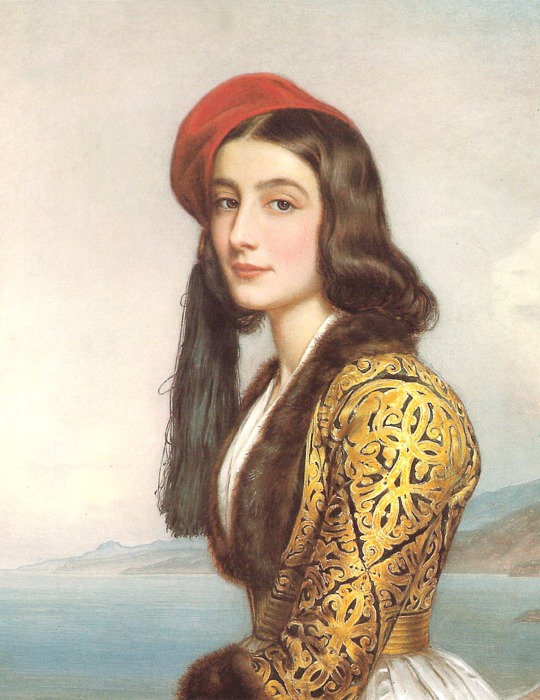


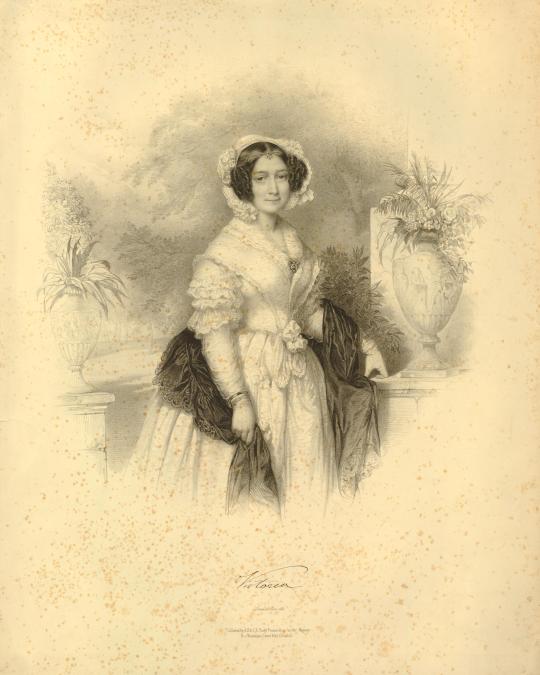
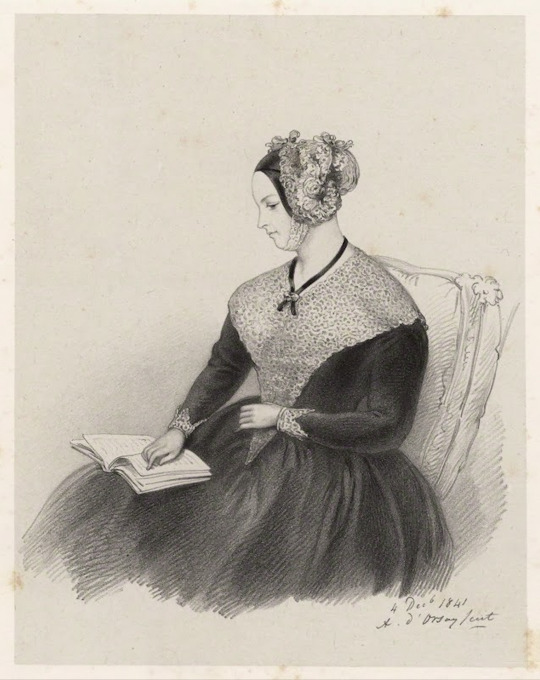

It’s 1841:
First row: 1841 Honourable Julia Henrietta Anson (1819-1866), Lady Brooke by Alfred Tidey (Royal Collection). From pinterest.com/msnelly1/romantic-era-dresses/ 854X1134 @72 1.3Mj.
Second row left: 1841 Karolina Lizius by Joseph Karl Stieler (Schönheitengallerie, Schloss Nymphenburg - München, Bayern, Germany). From Wikimedia 2077X2493 @96 1.5Mj.
Second row right: 1841 Katerina Rosa Botzaris by Joseph Karl Stieler (Schönheitengallerie, Schloss Nymphenburg - München, Bayern, Germany). Probably from Wikimedia 1694X2197 @72 1Mj. According to rrayedingold.blogspot.com/2011/11/gallery-of-beauties.html “Katharina was Greek beauty from Janina. Her father was a Greek freedom fighter named Markos Botzaris. He died in battle against the Ottoman Turks in 1820. Katharina's brother, Demetrius, was educated in Munich, and was an aide and war minister of King Otto I of Greece. Katharina became lady-in-waiting to Queen Amalie of Greece, and married Prince George Karadjas in 1845, a general in the Greek army. In 1841, Amalie, Otto, and their aides visited King Ludwig in Munich. While Amalie was climbing out of her carriage in Munich, Ludwig spotted Katharina assisting her. Both Otto and Amalie suggested Katharina for the Gallery of Beauties, and Ludwig agreed. She was portrayed here wearing the traditional Greek costume.”
Third row: 1841 Königin Therese von Bayern by Heinrich Wilhelm Vogel after Joseph Karl Stieler (Schloss Nymphenburg - München, Bayern, Germany), From Wikimedia; expanded to fit screen 1141X1400 @300 375kj.
Fourth row: 1841 Lady by Apollon Mokritsky (Kaluga Museum of Fine Arts - Kaluga, Kaluga Oblast, Russia). From Wikimedia 87)X1130 @96 279kj. There is considerable artistic talent practicing in Russia.
Fifth row left: 1841 Lithograph of Victoria Duchess of Kent by Pierre Émile Desmaisons (British Museum). From their Web site 2001X2500 @300 1.1Mj.
Fifth row right: 1841 Maguerite, Countess of Blessington by Alfred, Count d'Orsay (location ?). From hhistoryandotherthoughts.blogspot.com/2013/12; enlarged to fit screen 2284X2876 @144 6.8Mp.
Sixth row: 1841 Louise Marie Thérèse Charlotte Isabelle d'Orléans, reine des Belges by Franz Xaver Winterhalter (Châteaux de Versailles et de Trianon - Versailles, Île-de-France, France) From WikiArt 1226X1500 @72 433kj.
#early Victorian fashion#Romantic era fashion#1841 fashion#1840s fashion#Julia Henrietta Anson#Lady Brooke#Alfred Tidey#Karolina Lizius#Katerina Rosa Botzaris#Joseph Karl Stieler#Schönheitengallerie#Greek dress#Therese von Bayern#Heinrich Wilhelm Vogel#Apollon Mokritsky#Duchess Victoria of Kent#Pierre Émile Desmaisons#Maguerite Countess of Blessington#Alfred Count d'Orsay#Louise Marie Thérèse Charlotte Isabelle d'Orléans#Franz Xaver Winterhalter#off shoulder neckline#Vneckline#pleated bertha#hat#modesty piece#high neckline#lace collar#full skirt
14 notes
·
View notes
Photo

Lievin de Winne - Portrait of Marie of Hohenzollern-Sigmaringen - ca 1870

Princess Marie Luise Karoline Alexandra of Hohenzollern-Sigmaringen (17 November 1845 – 26 November 1912), later Countess of Flanders, was a princess of Hohenzollern-Sigmaringen, later simply of Hohenzollern. She married Prince Philippe, Count of Flanders, second son of King Leopold I of Belgium, and she was the mother of King Albert I.
Prince Philippe of Belgium, Count of Flanders (Dutch: Filips; 24 March 1837 – 17 November 1905), was the third born and second surviving son of King Leopold I of Belgium and Louise d'Orléans.
Born at the Château de Laeken, near Brussels, Belgium, Philippe was created Count of Flanders on 14 December 1840. Upon the death of his nephew Prince Leopold, Duke of Brabant, he became heir presumptive to the Belgian throne. In 1866, after the abdication of Alexandru Ioan Cuza, Prince of Romania, Philippe refused being named the new Romanian sovereign, and the throne was later accepted by Philippe's brother-in-law Carol I.[1] Earlier, he had also refused the crown of Greece, which was offered to him in 1862.
Philippe died in 1905. When his brother King Leopold II died in 1909, Philippe's second son ascended the Belgian throne as King Albert I.
Liévin De Winne (Ghent, 24 January 1821 - Brussels, 13 May 1880) was a Belgian portrait painter who painted the official portrait of Leopold I on which the first postage stamp of Belgium was based.
42 notes
·
View notes